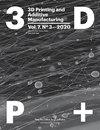利用双峰粒度分布增加数字光处理中的可印刷固体负载
IF 2.1
4区 工程技术
Q3 ENGINEERING, MANUFACTURING
引用次数: 0
摘要
数字光处理(DLP)作为一种用于复合材料结构制造的增材制造方法正在迅速普及,是制备高分辨率填充部件(如陶瓷绿色部件或复合磁体)的有效方法。然而,较高的树脂固体负载和由此产生的粘度急剧增加限制了DLP印刷的应用,这取决于填料含量的最大化。在这项工作中,我们研究了双峰粒度分布的能力,使印刷含有高达70 vol%填料的光敏树脂成为可能。制备了单峰和双峰固体载荷范围为50%至72vol %的配方,并通过旋转流变法测量了它们的粘弹性特性。这些配方的零剪切粘度与Krieger-Dougherty模型拟合,由拟合确定的致密随机紧密堆积分数为76.3 vol%。打印具有精细正负特征的部件,以评估高度填充的光敏树脂所能达到的分辨率。用70 vol%的配方打印的零件,其负极特征小至860 μm,正极特征小至380 μm。最后,用之前测试过的配方制备了具有复杂图案的零件,热重分析结果表明,在3小时的打印过程中,零件内的填料含量保持相对恒定,最终打印层的固体含量减少了2 vol%。本文章由计算机程序翻译,如有差异,请以英文原文为准。
Increasing Printable Solid Loading in Digital Light Processing Using a Bimodal Particle Size Distribution
Digital light processing (DLP) is rapidly growing in popularity as an additive manufacturing method for the fabrication of composite structures, and is an effective way to prepare high-resolution filled parts, such as ceramic green parts or composite magnets. Yet, higher solid loadings of resins and the resulting dramatic increases in viscosity limit DLP printing for applications that depend upon maximization of filler content. In this work, we investigate the capacity of a bimodal particle size distribution to enable the printing of a photosensitive resin containing up to 70 vol% of fillers. Formulations with unimodal and bimodal solid loadings ranging from 50 to 72 vol% are prepared and their viscoelastic properties measured through rotational rheometry. The zero-shear viscosity of these formulations is fit with a Krieger-Dougherty model, and the dense random close packing fraction of particles determined from the fit is found to be 76.3 vol%. Parts with fine positive and negative features are printed to evaluate the resolution achievable with highly filled photosensitive resins. The part printed with a 70 vol% formulation shows negative features as small as 860 μm, and positive feature as small as 380 μm. Finally, parts with complex patterns are prepared with previously tested formulations, and thermogravimetric analysis results show that the filler content within the parts remains relatively constant over a 3-h print, with a decrease of 2 vol% of solids for the final printed layers.
求助全文
通过发布文献求助,成功后即可免费获取论文全文。
去求助
来源期刊

3D Printing and Additive Manufacturing
Materials Science-Materials Science (miscellaneous)
CiteScore
6.00
自引率
6.50%
发文量
126
期刊介绍:
3D Printing and Additive Manufacturing is a peer-reviewed journal that provides a forum for world-class research in additive manufacturing and related technologies. The Journal explores emerging challenges and opportunities ranging from new developments of processes and materials, to new simulation and design tools, and informative applications and case studies. Novel applications in new areas, such as medicine, education, bio-printing, food printing, art and architecture, are also encouraged.
The Journal addresses the important questions surrounding this powerful and growing field, including issues in policy and law, intellectual property, data standards, safety and liability, environmental impact, social, economic, and humanitarian implications, and emerging business models at the industrial and consumer scales.
 求助内容:
求助内容: 应助结果提醒方式:
应助结果提醒方式:


